Every summer resident seeks to get a large harvest from his hundred parts. Weeds are one of the main obstacles to achieving the desired result. They take away nutrients and life-giving moisture, sun rays and space for the development of the root system from fruit and vegetable crops. The fight against harmful plants takes a lot of time and effort, so necessary to perform other equally important work in the garden and vegetable garden. Herbicides come to the aid of the gardener. The editors of the site "bestx.htgetrid.com/en/" present an overview of "The best weed control products for 2020", compiled by the opinion of buyers and experts.
Content
What are herbicides
First, let's figure out what it is.
Interesting! The term is formed by two Latin words "herba" - grass and "caedo" - I kill. These chemicals destroy harmful plants that are a serious competitor to crops.
The mechanism of action on weeds is different for them, but the assigned tasks are solved with their help in a very short period of time and with maximum effect.
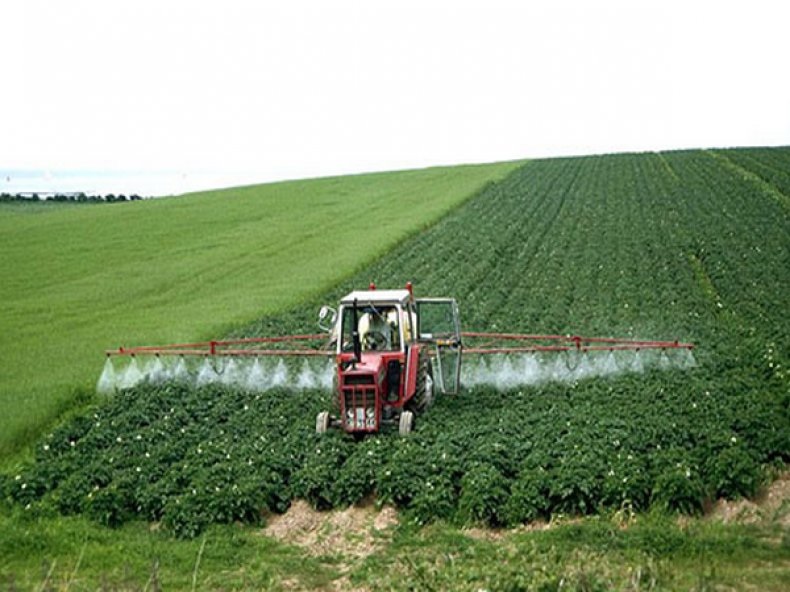
All known substances for the destruction of unwanted vegetation are divided into groups, depending on certain properties. Let's consider the main ones.
Chemical composition
According to their chemical properties, the compositions are divided into:
- organic, not harming people and animals, agricultural crops;
- inorganic, toxic to varying degrees, the use of which requires the use of personal protective equipment and the absence of children and animals in the work area.
The former are preferable, in view of the fact that their use does not limit the gardener in crop rotation, does not harm crops, and even their accumulation in the soil does not threaten troubles. The latter, together with harmful plants, can destroy part of the crop. Accumulating in the soil, toxic substances fall on the table along with vegetables and fruits.
Method of exposure
- Substances of continuous action. Destroy any greenery they hit. For this feature, they are called universal. They are rarely used for cultivating agricultural land. They are more often used for the destruction of vegetation along roads, at construction sites, etc.
- Selective or selective exposure. They effectively destroy certain plants. They are widely used in agriculture. May have a wide range of effects or effectively protect certain crops. For example, Betanal Expert PF is very effectively used to protect beets, sugar and fodder. Lapis lazuli is used to protect potato plantings.
- Contact formulations are called compounds that, if they hit the surface of the grass, cause it burns and lead to death.
- Systemic action.Substances penetrate into the structure of the grass, accumulate in points of growth, root system, stop photosynthesis or dehydrate the "object". As a result, the plant dies completely and will no longer germinate.
The difference in the method of exposure is often very arbitrary.
Interesting! The same herbicides can, under certain conditions and at different concentrations, work as selective or continuous action. Certain chemicals in low concentrations work as growth promoters.
Method of application
- Root. They are introduced into the soil in granules, or diluted in water, delivered to the roots by drip irrigation.
- Leafy. They are diluted with water, followed by spraying of harmful plants.
- Soil. In the form of a powder, they are scattered over the ground or the soil is spilled with an aqueous solution.
Terms of application
- Pre-emergence. They are applied before the plants sprout.
- Postemergence. Before applying, wait until the grass germinates, reaches a height of 15 - 20 cm, overgrows with 4 - 5-leaves. Then all the shoots are processed and die within two to three weeks. Then the sowing campaign is carried out.
Selection criteria for herbicides
Depends on the conditions of use and the tasks solved by the farmer. What substances to choose in what cases to choose will consider here.
Selective
Experienced summer residents often choose this option. The popular composition "Lontrel" will help to clear the planting of strawberries from weeds and grass. It degrades quickly in the soil and does not harm the main crop.
For "putting things in order" on the lawn, its analogue "Propolol" is recommended. His specialization is dicotyledonous weeds (more than a hundred species). Within a month after treatment, this composition will not leave a trace of them.
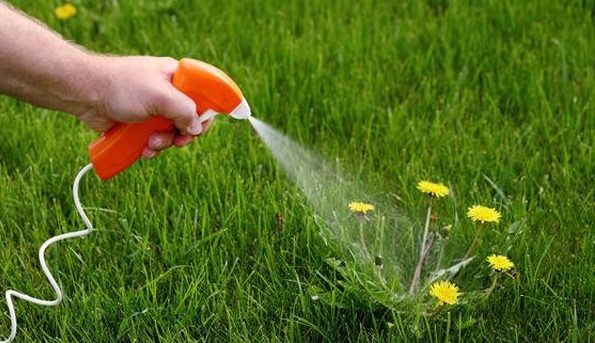
Means of continuous action
The working substance here is glyphosate (indicated on the package). It is successfully used against most weeds. As an example, let's name the popular products: Hurricane and Tornado. The maximum effect from their use is observed in areas "densely" populated with harmful grass that has gained sufficient green mass, while it is desirable to shelter cultivated plants from their influence.
It is best to use slaughter substances on areas not yet sown or after the harvest has been taken.
The main thing to pay attention to when choosing "chemistry" for a summer cottage is its toxicity. This property must be written on the packaging. Leave such poison to the farmers. There is no need to strangle a small piece of land with such powerful means. Selective compositions will be enough.
Important! Thoughtless and inept use of herbicides can, instead of benefit, kill the flora and fauna of the summer cottage and cause irreparable harm to human health.
Before using potent chemicals in the fight against unwanted vegetation, you should consult with specialists, listen to the advice and recommendations of experienced farmers, carefully study the description and step-by-step instructions for its use.
Top manufacturers
Syngenta AG
Swiss company. Year of foundation 2000. Representative offices in 90 states. Manufacturing of Herbicides, insecticides, fungicides, growth regulators, pre-plant seed treatments, etc.
Bayer Crop Science
The oldest German company. Founded in 1863 in Bremen. She was engaged in the production of synthetic paint. Today it is the largest manufacturer of plant protection products. Herbicides Agritox, Mays Ter Power have deserved popularity.
BASF
Transnational concern engaged in the development and production of various chemical products. Founded in 1865, locations - Baden, Germany. BASF's business segments include chemicals, plastics, oil, gas, catalysts, construction chemicals, coatings. The agricultural sector is just a small part of the company's interests. Its divisions produce a full range of protective agricultural chemicals including insecticides, fungicides, pesticides and herbicides, seed treaters, and more.
DuPont
American company, founded in 1802.In those days, it produced gunpowder. Today one of the largest companies in the global production of chemicals for various purposes. Her areas of expertise include food processing, construction, oil and gas, power generation, agriculture and crop protection solutions. Has its own backwaters in Russia.
Nufarm Ltd
International company for the production of plant protection products. The main activity is fungicides, pesticides, insecticides and herbicides, growth regulators and seed treatments. The year of registration is 1916. The initial activity is the production of fertilizers for farms in New Zealand.
B. Sumitomo Chemical Co., Ltd
Japanese manufacturer of a full range of plant protection products, including herbicides
Nutrichem Company Limited
Chinese designer and manufacturer of original fungicides, pesticides, insecticides and herbicides.
Company "August"
Russian producer of plant protection products, the largest in the country. On the market since 1990. The company's divisions are present in 20 countries around the world, incl. in Central and South America, Africa and the Middle East.
Green Pharmacy Gardener
Russian company founded in 1996. The main products are inexpensive plant protection products for personal subsidiary plots, of our own design, packaging of similar compositions from world manufacturers (Syngenta, Dupont, Keminova.).
Which company is better to buy a tool, the buyer decides, based on his needs, the size of the site, the mastered farming techniques. It is worth carefully reading the description, understanding the expense and clarifying how much it costs, and then make an informed decision. You need to understand that there is no such chemical that can permanently rid your garden of unwanted vegetation. Plant care involves repeated treatments every season.
Where can I buy
The easiest way to do this is in specialized retail outlets, for example, in the Planet Gardener chain of stores. In addition, manufacturing companies have their own trading platforms, the addresses of which can be established by visiting their official websites. Finally, you can order the product online from a trusted online store. You can check their addresses on the Yandex Market website.
DIY herbicides
Some summer residents try to avoid using chemicals on their plots. All the same poison! But there are plots in the country that are overgrown with solid grass, and the owner decided to use them for planting a crop. How to deal with this without chemistry? Digging and knocking out of the ground is not effective and takes a long time. But you can make folk remedies yourself, at home from scrap materials. Here are some recipes describing how to make your own potion:
- A preparation of vinegar, citric acid and alcohol. You will need half a liter of cold water, where you need to dissolve half a liter of vinegar, a bag of citric acid and no more than 30 g of alcohol. To enhance the effectiveness, add a detergent to the solution (two tablespoons).
- A very popular vinegar and salt home remedy. To do this, dissolve a tablespoon of salt and detergent (a few drops) in a liter of vinegar.
- Salt. Helps to remove vegetation from garden paths. For this, one and a half kg of salt is dissolved in a bucket of water. Nothing else will grow in the area treated with this concentrate.
Quality herbicide rating
We offer TOP 10 formulations for plant protection against weeds. For ease of perception, it is divided into two parts.
The best preparations for small areas
Miura, KE
Fifth place.
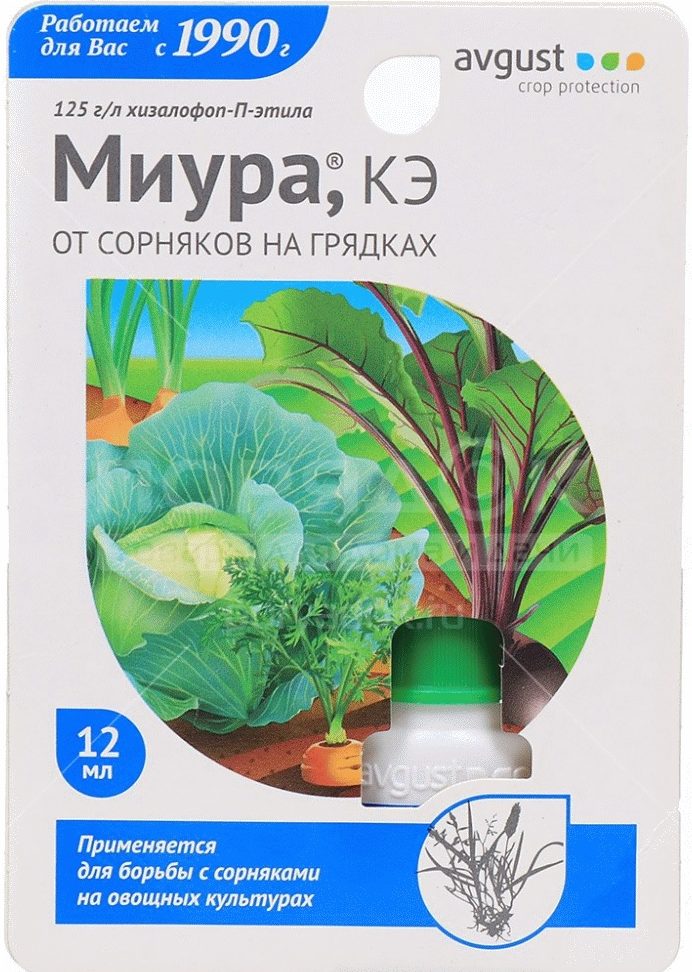
A versatile compound that can deal with the destruction of most weeds. Acting selectively, it will not harm cultivated plants. The high concentration of the active substance allows it to penetrate into the structure of plants when evaporated from the soil or when applied to leaves, starting the destruction process after two hours. Most effectively protects beets, flax, soybeans, onions, cabbage, carrots and potatoes. Release form - concentrated emulsion in a vial with a capacity of 12 ml.Before use, dilute with water in a ratio of 4 to 8 mg / 5 liters. The finished composition is enough for processing 100 sq. Cm. crops. The average cost of a package will be 70 rubles. Not a bad composition for any garden or vegetable garden.
Advantages:
- quickly penetrates the structure of plants;
- complete death of the drug ensures you within 3 weeks;
- low consumption;
- affordable price.
Disadvantages:
- due to the toxicity of the drug, the treatment should be carried out in a protective suit, gloves and a respirator.
Sniper 50 ml
Fourth place.
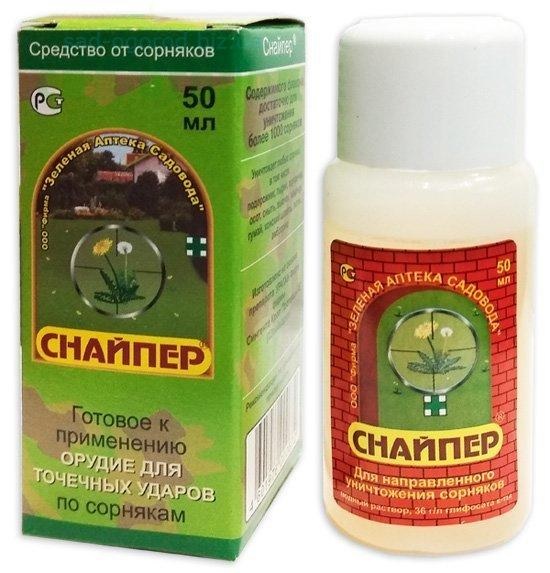
Means from the Russian company "Green Pharmacy Gardener". Selectively destroys harmful weeds. Release form - an aqueous solution in a 50 ml bottle. This is enough to handle 100 sq.m. It is used to get rid of the plot of wheatgrass, dandelion, sow thistle, etc. The result is visually discernible in two to three weeks from the moment of treatment. Unwanted plants are treated with a sponge or brush moistened with the composition. The average cost will be 55.9 rubles. Quite a budget option for the garden.
Advantages:
- a wide range of effects;
- non-toxic;
- does not accumulate in soil and weeds.
Disadvantages:
- inconvenient to use;
- contact with the protected crop or lawn grass will lead to the death of plants.
Tornado Extra, 90 ml
Third place.
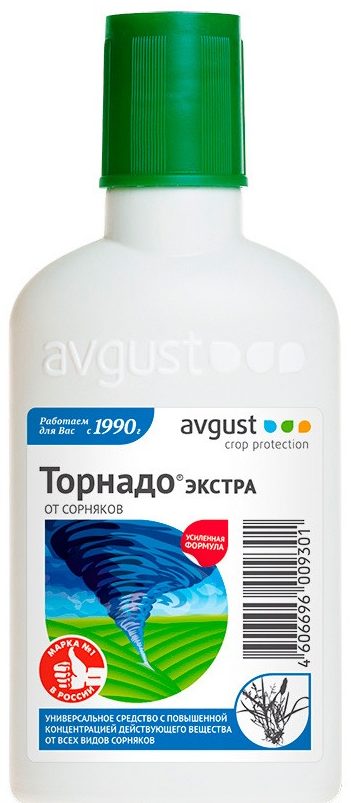
A universal preparation that destroys any, even the most unkillable weeds, bringing them to the complete death of leaves, stems and roots. Frees the cultivated area from unnecessary shrubs. The active ingredient is glyphosate. Release form - aqueous solution. Packaging - bottle 90ml. When used, it is diluted in a proportion of 30-50 ml per 3 liters of water. This is enough for processing a plot of 100 sq.m. The average cost of a package will be 295 rubles. Manufacturer - AO firm August, RF.
Advantages:
- an excellent tool for dealing with unnecessary vegetation on lawns;
- destroys all types of weeds on garden paths, along fences and fences, in a cemetery, in a word, in areas not intended for sowing;
- affordable price;
- low consumption.
Disadvantages:
- the preparation is toxic, processing is carried out in protective suits, with the obligatory removal of animals and children from the zone.
Lapis Lazuli, SP 20 g
Second place.

Another product from the August company. A universal preparation of pre-emergence and post-emergence action. Provides protection of potato plantations from unwanted vegetation for two months without adversely affecting the crop itself. When used correctly, it completely kills weeds at the moment of germination. When processing the planting after the emergence of the grass, it kills it in 10 - 20 days. Before use, it is diluted in a proportion of 10 g / 3 l of water. The resulting solution is enough for processing 100 sq.m. area. Release form - powder in packages of 20 g. The average cost of a package will be 178 rubles.
Advantages:
- equally active in pre-emergence application and with emergence;
- low consumption;
- affordable price;
- non-toxic.
Disadvantages:
- not identified.
Chistogryad 500 ml
First place.
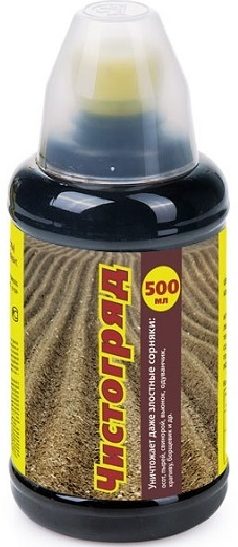
A novelty among the products designed to combat unwanted vegetation in small areas. A continuous herbicide and a desiccant (causes dehydration of plants) in one bottle. It is applied two weeks before the planting of fruit and vegetable crops and lawns, on emerging weeds. It successfully fights against wheatgrass, thistle-thistle, bindweed, etc. Perennial and wintering grasses can be processed by Chistogryad after harvesting. Berries and grapes should be carefully protected from contact with the preparation before processing.
The drug is diluted in a plastic container until it works. First, all the contents are diluted in one liter of water, then the resulting composition is added to 3 liters. The funds received are enough to process 100sq.m. area. The average cost of a 500 mm bottle will be 590 rubles. An excellent option for giving.
Advantages:
- guaranteed destruction of most weeds, including malicious ones;
- the result is achieved within three weeks;
- low consumption;
- affordable price.
Disadvantages:
- not identified.
Best herbicides for large areas
Betanal Expert PF
Fifth place.
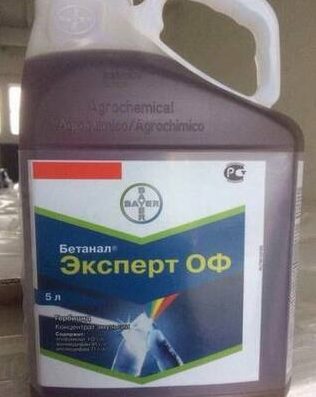
The German company Bayer offers a selective action, postemergence application that destroys annual dicotyledonous and some cereal weeds, such as chicken millet, bristles, and field broom. Protected crops are sugar, table and fodder beets. Release form - emulsion. Coming into contact with the plant, the drug stops the process of photosynthesis.
Crops are processed in the morning or evening hours, consuming 200 - 300 l / ha. The result of exposure is visually observed after 3 days. The plantings are sprayed one to three times per season. 100% death of weeds on the vine occurs after two weeks. It is sold at a price of 14,640 rubles for a five-liter canister.
Advantages:
- a wide range of effects;
- complete destruction of weeds;
- a long period of protective action.
Disadvantages:
- high price;
- high consumption.
Basis
Fourth place.
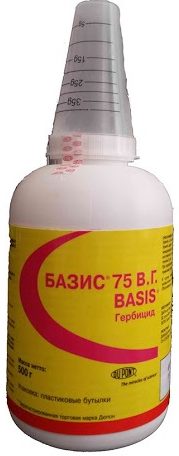
The drug belongs to the postemergence. Effectively fights against all cereals and copes well with dicotyledons: wheatgrass, thistles, thistle. The protected crop is corn for silage and grain. Maximum concentration of active ingredients in the preparation:
- rimsulfuron 500 g / kg;
- thifensulfuron - methyl 250 g / kg.
Both are developed by DuPont.
As a result of processing, weed shoots stop growing in just a few hours. Visually, the results are observed in 5-7 days, the complete destruction of harmful herbs occurs in two weeks. The preparation dissolves rather quickly in the soil and does not require changes in the usual crop rotation. Consumption - 25g / ha.
Important! "Basis" is used only in a mixture with "Trend 90" adhesive. It is a surfactant (surfactant). It is necessary for sufficient wetting of weed seedlings, at a concentration of 100 g per 100 g of working substance.
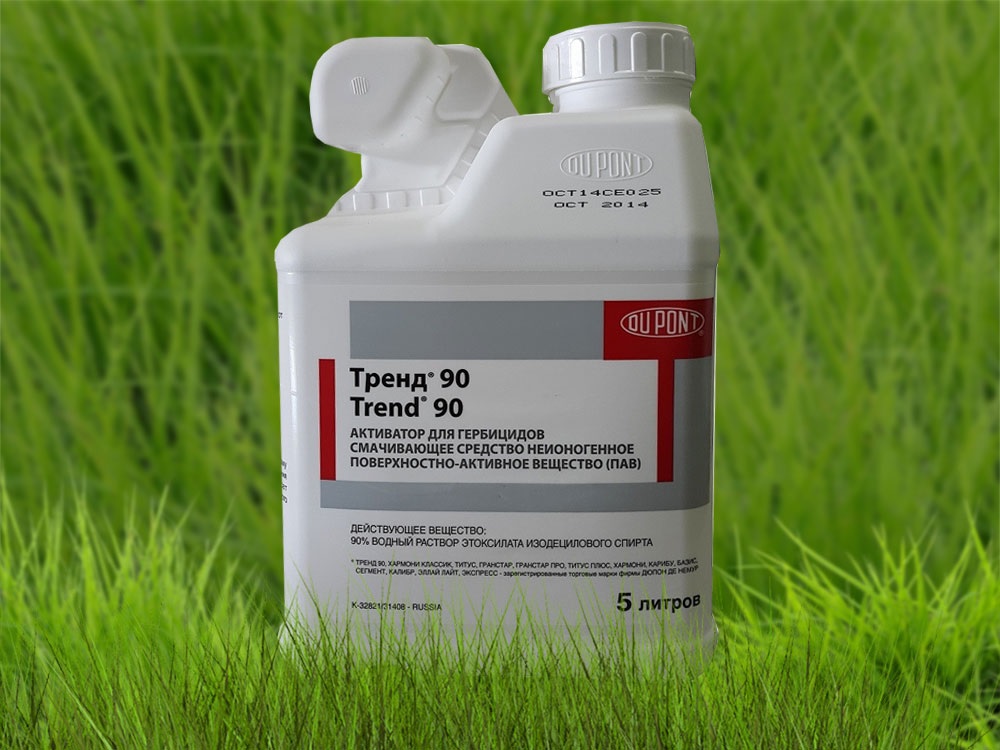
The average cost of the drug "Basis" is 80 rubles / liter (kg). The adhesive trades at an average of 500 rubles per liter.
Advantages:
- extended spectrum drug;
- economical;
- does not limit crop rotation;
- does not lose effectiveness in drought conditions.
Disadvantages:
- on the day of drug use and on the next day, the air temperature should not exceed + 25 ° C;
- the cost of the Trend 90 adhesive exceeds the cost of the herbicide.
Bazoran 20 l
Third place.
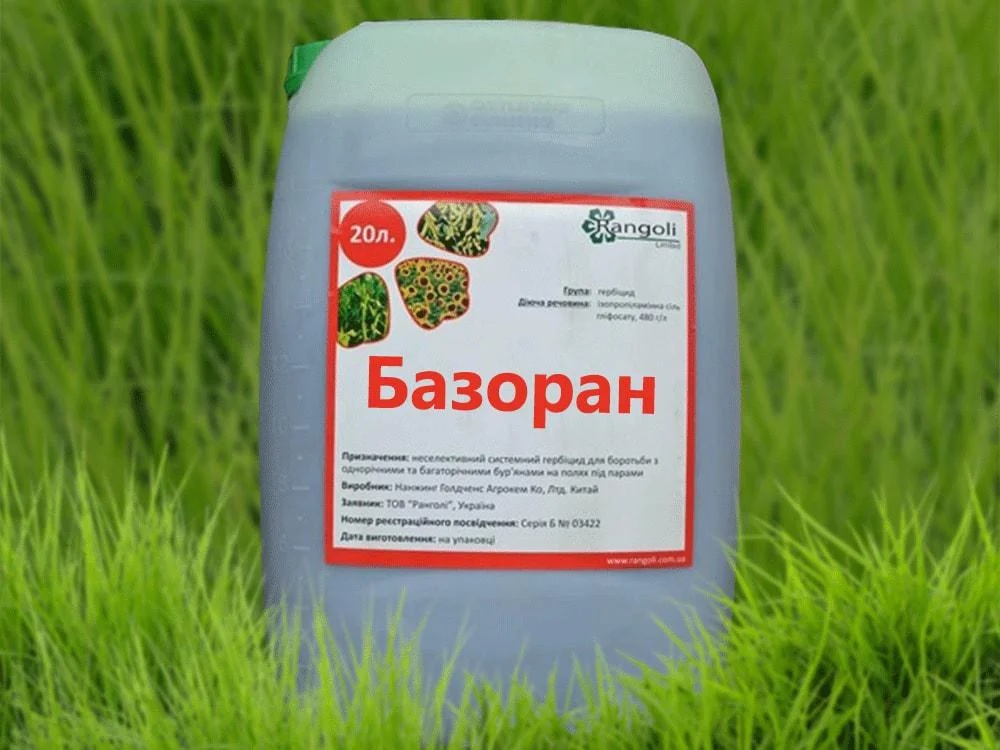
The drug is in the form of an aqueous solution. The active ingredient in its composition is benzathone, a herbicide manufactured by BASF Chemicals. It is widely used for crops of cereals, soybeans, corn, millet and fiber flax. It successfully suppresses the growth of field forget-me-not, wild radish, garden purslane, shepherd's purse, cornflower, chamomile, quinoa. With varying degrees of success wins over nettle, field bindweed and field violet.
The crops are sprayed after the weeds sprout, at an air temperature ranging from +10 to + 25 ° C. At the same time, they make sure that no precipitation falls in the next 4 hours after processing the field. The wetting of leaves and stems of unwanted seedlings should be abundant. Subject to all conditions, weeds die in two weeks. Sold in a plastic container with a volume of 20 liters. Consumption up to 300 l / ha. The average price per liter will be 967.68 rubles.
Advantages:
- gives excellent results as a selective herbicide in the protection of soybeans and peas;
- has a high selectivity to protected crops;
- differs in low toxicity for warm-blooded animals;
- harmless to bees.
Disadvantages:
- high price.
Panther
Second place.
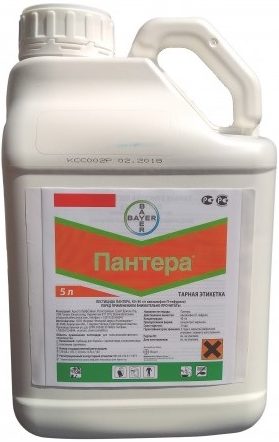
The best customer reviews are received by the herbicide of systemic postemergence action "Panther". Manufacturer - American corporation Chemtura. The drug actively destroys annual and perennial cereal and dicotyledonous weeds. Protects vegetable plantations, fodder and industrial crops. Available in the form of an emulsion concentrate.They are used to protect sugar beets, potatoes, soybeans and onions, oil flax, carrots, tomatoes and cabbage, winter and spring rape. After contact with the herbicide, lipid synthesis stops, and the harmful grass dies in the bud. Consumption - from 0.7 to 1.5 liters per hectare of crops. The average cost of a five-liter canister with the drug is 7450 rubles.
Advantages:
- mercilessly, by the roots destroys weeds that are difficult to eradicate;
- one hour is enough to penetrate the harmful grass;
- enough for decomposition 6 hours, which speaks of the environmental friendliness of the "Panther";
- application gives a quick result, visible visually after three days.
Disadvantages:
- not identified.
Hurricane Forte
First place.
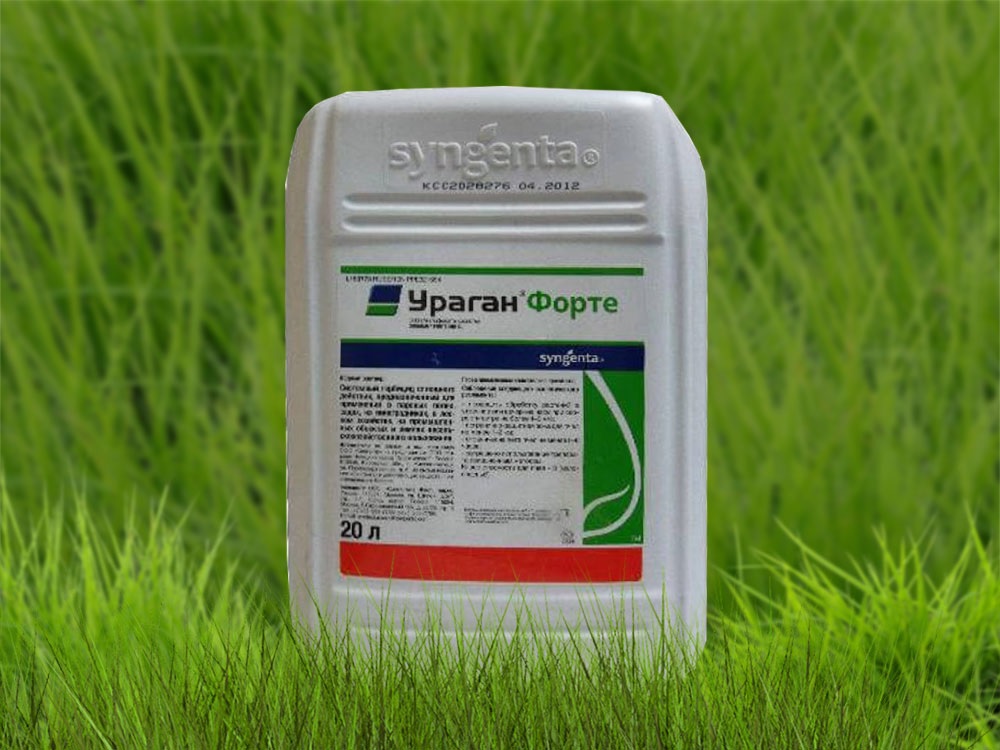
Swiss agent for the control of highly active weeds. Manufacturer - Syngenta company. The drug is continuous action. It is successfully used against all types of weeds, all unnecessary vegetation. Areas that are allotted for fallows, orchards and vineyards, landscaping of industrial sites, summer cottages and forestry plantings are subjected to processing. The active ingredient is glyphosate, which has excellent penetrating properties. It even seeps through the bark. The substance accumulates in plant tissues, slows down, and then completely stops all life processes.
The spent herbicide does not accumulate in the soil and decomposes soon. Therefore, it makes no sense to apply it before the emergence of the grass. Areas treated in the current season are not sown. In the next season, no weeds will germinate in the areas. The average cost of a twenty-liter canister will be 18888 rubles.
Advantages:
- copes with all types of weeds;
- does not accumulate in the ground;
- harmless to insects.
Disadvantages:
- toxic, safety precautions are required during operation.
Any herbicide is, first of all, a poison, and its use harms the soil, reducing its fertility, changing the acidity, and disrupting the balance of trace elements. In addition, the improper use of pesticides can lead to their accumulation on fruit and vegetable crops and get on the table with them.
At the same time, the competent use of such powerful agents in the fight against harmful herbs will not only not harm agricultural crops, but will seriously increase their productivity, i.e. will increase the return on labor invested. The editors of the site do not claim to be true in the first instance. Our review is intended to acquaint novice gardeners with the most popular herbicides, tells what they are, how much a particular drug costs, how to choose a suitable weed control agent and not make mistakes when choosing.












